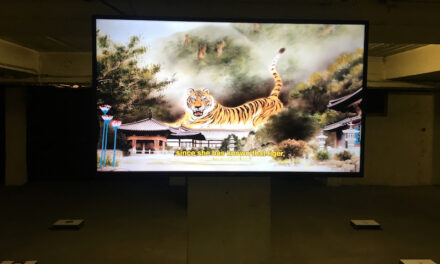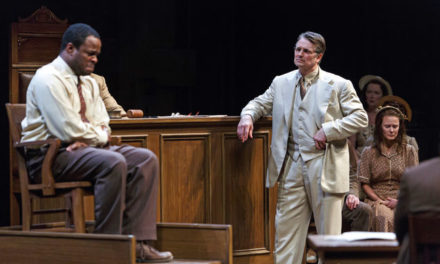Ballet Alice in Wonderland, and operas Carmen, Die Tote Stadt, and Das Rheingold.
At the Finnish National Opera and Ballet (FNOB), situated in the heart of Helsinki on the beautiful Töölö lake, visions of the unknown and longings for the not-yet-experienced have formed the start of the 2019/2020 season, ranging from a dream of a child to a God’s vision of the world’s future. The Opera House, with its beautiful row of windows overlooking the quickly gathering dusk, and its first-class technical opportunities, creates visual worlds that draw the audiences in. The invited conductors add to these worlds by creating their unforgettable soundscapes to enhance the overall illusion. A place to dream, to long, to desire, to be disillusioned and yet live on with the memory of a beautiful hypnotic moment – this is what the FNOB has been creating, as Nordic days grow shorter and nights grow longer and darker.
The first of these performances is ballet, Alice in Wonderland: its world premiere took place in October 2016, but it is still immensely popular with children and adults alike. Lewis Carroll’s story of a girl escaping to her dream world has been fascinating readers for over a century. The creators of the ballet have endeavored to modernize this story by introducing gripping animations (Petri Sarkkila), projection videos, and lighting design (Mikki Kunttu) into its fabric, while the set and costumes (Robert Perdziola) still draw on the Alice of Carroll’s times. This amazing combination makes us instantly comfortable, seeing Alice as we expect her, but with a moving digital rabbit that disappears into a 2D drawn picture or a set of doors that appear and change size. Both children’s and adults’ visualization skills are triggered by the inventiveness of the creative team. Objects swell and disappear, the Cheshire Cat is body-less, and the dream abodes of the Duchess and the Queen appear as real structures, although they are obviously not. The nature of a child’s dream is skillfully captured through these projections and animations, and they impress and captivate throughout the ballet.
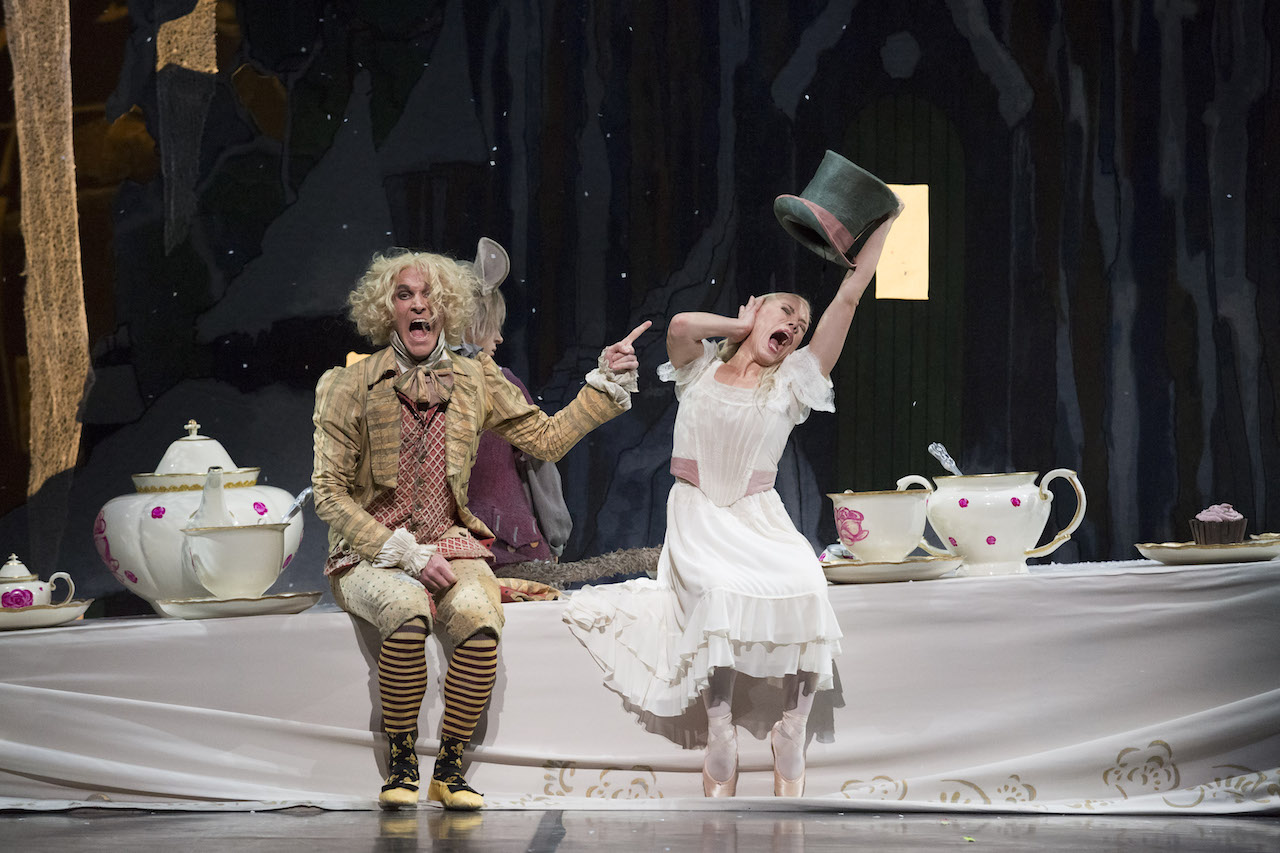
Alice in Wonderland at FNOB, 2019. Photographer: Mirka Kleemola.
However, the ballet itself, choreographed by Jorma Elo, with its story slightly modified (Alice has a background story involving a father who dies and a ball she escapes from), and its music compiled of famous numbers from multiple composers (Bach, Beethoven, Handel, Grieg, Haydn, etc.) leaves an impression of mild and very pretty entertainment, not exactly corresponding to the world created by the visual team. There is too much nice dancing (which seems to extend the story to give the dancers a chance to show their skills) and the music does not create flow seamlessly but is patched together with specific numbers. Children as small porcupines were excellent (trembling and moving with every blow), as were the animals that follow Alice (the ones she meets gradually on her way to the Palace) – each with their unique set of movements. A scene at the Duchess’ abode and a meeting with March Hare and Mad Hatter are excellent, inventive and dynamic, but the ballet somehow exhausts its treasure of fantasies towards the second half and the moments that should be full of suspense somehow drag along, as though the whole piece loses its energy and moves forward by sheer inertia. A bourgeois beginning and ending of the ballet are also a slight disappointment, as compared to the fantasy flight of its middle – scenes of Alice growing in a nice house and then finding her Prince and dance partner seem to belong to a completely different story and would astonish those who know the book. It was an ambivalent evening that started with excellent intentions but didn’t balance them well enough to get a sense of fulfillment. However, children around me loved it, not paying much attention to such discrepancies, and the success of the ballet through several FNOB seasons proves its continuing worth and ability to fascinate.
The next tale of longing for dreams takes us to the world of the youthful passions of Don José and Carmen – moving from the child’s universe presented in Alice in Wonderland, to an adolescence/youth stage of the development. This Сarmen is not a new production, but another revival of the premiere dating back to 2007, with the original creative team including director Arnaud Bernard, set designer Alessandro Camera, costume designer Carla Ricott, choreographer Gianni Santucci and lighting designer Patrick Méeüs. The director and his team transferred the story to Spain in the 1930s, just before the outbreak of the Civil War and the longing to escape a soldier’s routine and follow one’s passion is not as romantic here as in the original story by Prosper Mérimée. The intention of Bernaud’s was to make it crude, to show social unrest, to show people working and struggling with freight cars and rifles, and to show the beginning of something that would divide the country in two. He wanted to visually intensify the inequalities, with a hint of Marxist message thrown in, as the smugglers José join could be those who want to restore the equality (with unfair methods, like it always is during civil wars), and the lush apartments of Escamillo in the last act are a glimpse into the rich lives of those who don’t care about rising unrest in the streets.
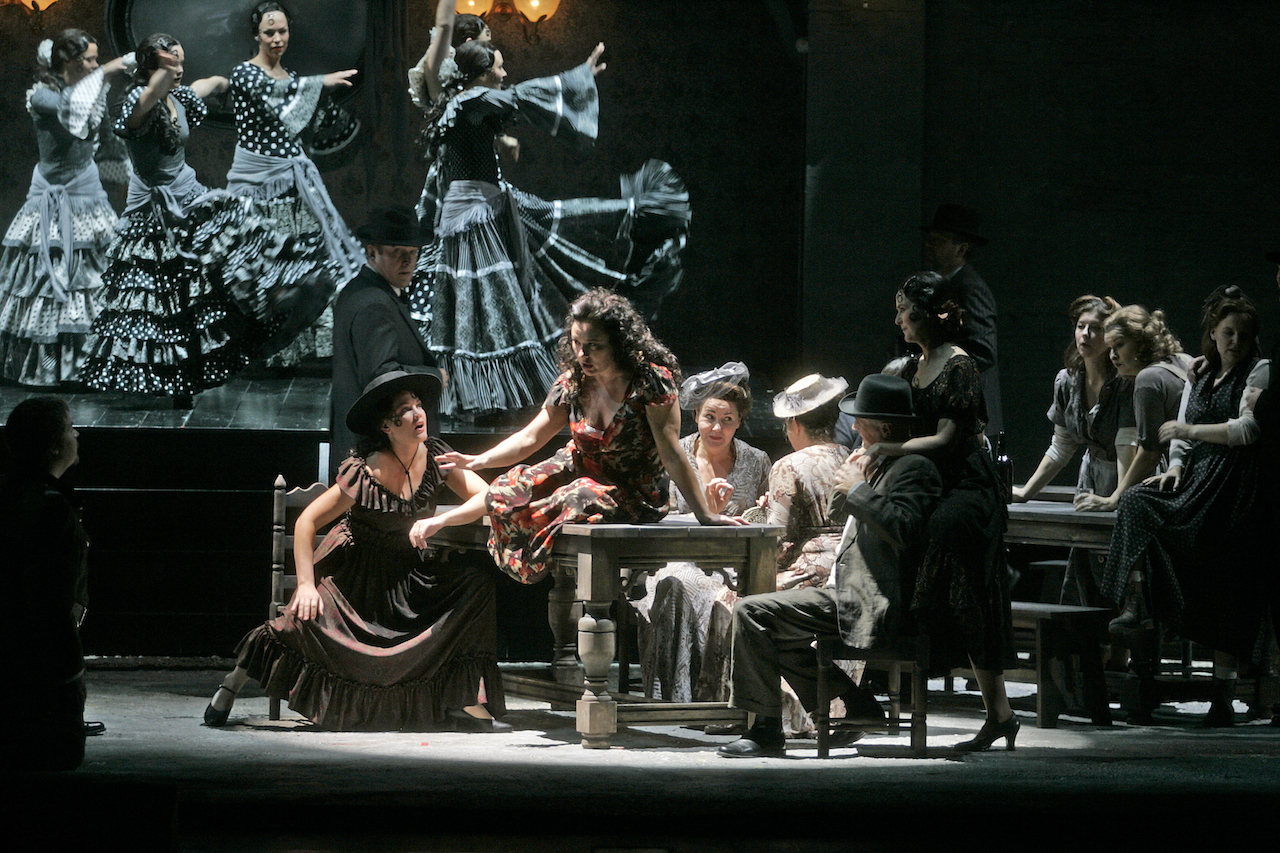
Carmen at FNOB, 2019. Photographer – Heikki Tuuli.
This message is very convincing, but Don José’s plight is thus stripped of all romanticism – he is driven by pure passion and he fails to fulfill any of his dreams, as his fitful obsession, Carmen moves back to the world she seemed to despise and into the arms of the toreador. The final act is sheer madness in this take on an opera, and devoid of any heroism. We are not able to empathize with either Carmen or Don José in the final scene – they (and the viewers) are left with the bareness of disillusioned life, as the stage also becomes an empty void of nothingness. She doesn’t love him, and there is no reason, no fair decision, no generosity and no historical reason for it – the youthful dream is over. Adolescents sometimes commit suicide at such disparaging, desperate moments – and so does José. He has proved not to be ready for adult life, and thus he is erased from it, taking his red flower of hope, his dreams and his passions with him.
It is an interesting concept, which unfortunately was not supported by a strong cast in this production. It takes a huge effort not to enjoy George Bizet’s music, but that was the case this evening. It was not the fault of Patrick Fournillier, the Principal Guest Conductor at FNOB, although his orchestral reading was slower than usual, and his choices shied away from brave contrasts in dynamic and poignant changes of tempi. It was the cast that disappointed me most in this production, with Luc Robert not fulfilling the directorially implied role of a youthful and struggling officer, and Iryna Zhytynska always trying to be on top of her lines, with her effort so visible that one was not charmed by her heroine. Franco Pomponi as Escamillo was also not delivering well enough, while the best in the cast was Liine Carlsson as Micaëla, who vocally brought the opera in tune with our expectations with her beautiful, longing, tender and strong arias. I could only wish the casting connected Bizet’s music and Bernaud’s directorial vision more, as at some points it felt that the singers were filling the slots left for them in the show rather than inhabiting them with ease, passion, and operatic grace. Thus, it was another world of longing and desire, well envisioned, but not fully realized on stage, perfection still escaping the productions of the FNOB season.
Another production, seen later in the season, is a very mysterious, cinematic opera Die Tote Stadt (1920, The Dead City) by Erich Wolfgang Korngold under the music directorship of the Finnish maestro Jukka-Pekka Saraste. Here, the longing for a dream moves to the sphere of intense adult emotions, where a human mind builds a world to escape reality. The libretto, written by Korngold together with his father Julius (under a pseudonym Paul Schrott) is based on a novel (and a play) by Georges Rodenbach where a man living in Brugge creates a shrine after the death of his wife and finally strangles a dancer Jane, who looks like her, with his wife’s hair. The twist of the opera is that the meeting of Paul (the main protagonist renamed) with Marietta (a woman who looks like his wife Marie) turns out to be a dream. After, he rejects seeing this woman in real life and returns to worshipping his deceased wife. Here, the fantasy world is not just an escape – it becomes a flood; a universe that encapsulates the smallest possibility of real life. If life is just a dream, who can tell us that we are not living in a fantasy world created to escape the unbearable pain of reality? As Proust once pointed out, there is no other way to do it. This protective shield of dreams is the only way to be alive. The borders between death and life, dream and reality are forever blurred in this strange opera.
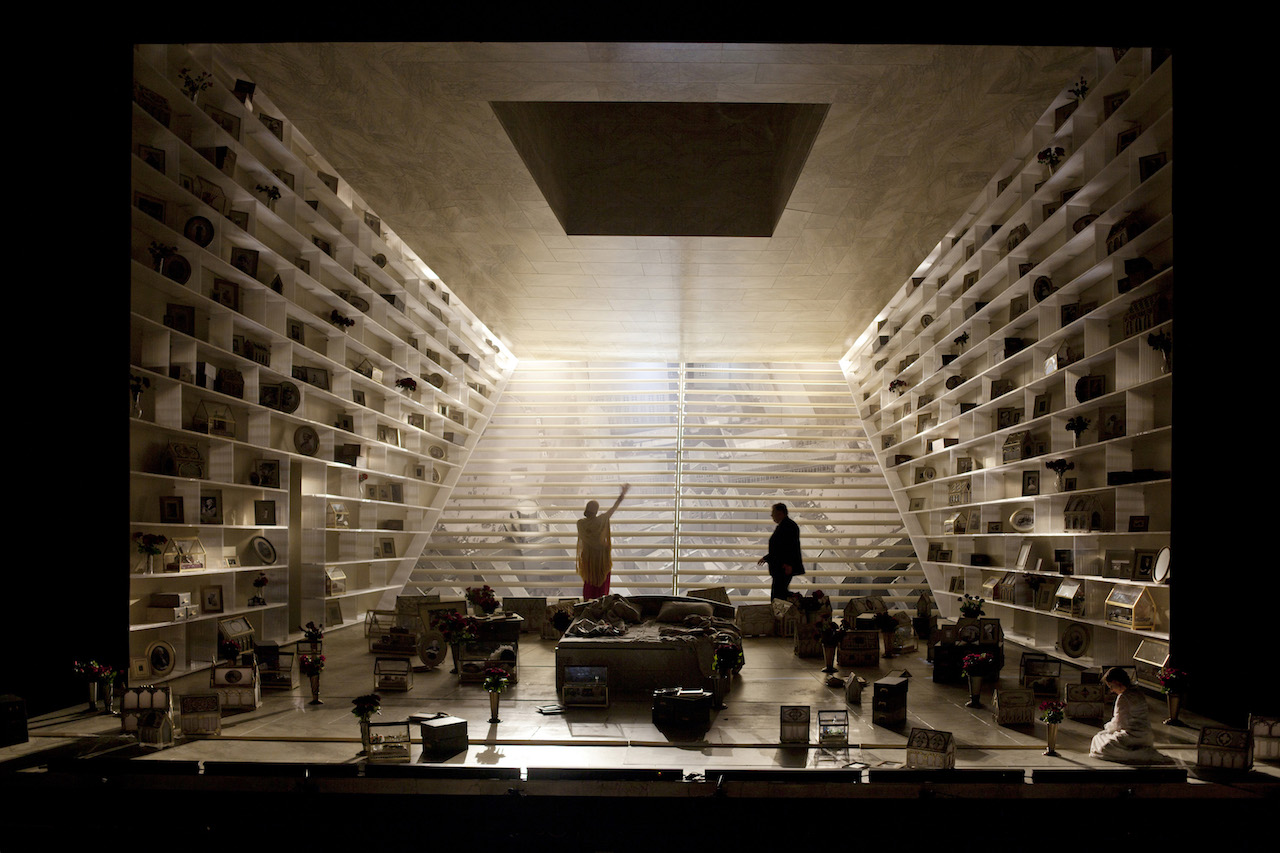
Die Tote Stadt at FNOB, 2019. Photographer – Stefan Bremer.
The production had its initial premiere at FNO in 2010, with a creative team including director Kasper Holten, set designer Es Devlin, costume designer Katrina Lindsay, light designer Wolfgang Goebbel and choreographer Signe Fabricius, and in 2019 it has been reworked by the director Anna Kelo. The set is very impressively organized, with the whole stage initially filled with images of Maria and objects belonging to her, not as they would be in a real room, but multiplied by hundreds, filling endless shelves up to ceilings. They cover the whole stage that narrows from the front to back, forming a claustrophobic feeling of a shrine/museum that is dead and slightly rotting. The bed later opens up and allows people from the city inside it, although, with their heavily painted faces and strange clownish attires, they also don’t look very real. The back wall at some point lifts to reveal a beautiful model of the city with red lights in different buildings and rooms, creating an astounding panorama filled with citizens (adults and children) singing, with their faces and bodies also protruding from the stage itself. The way the set is done shows the continuous discrepancies in scale, and the possibilities of impossible – almost like in Alice in Wonderland earlier, but with a much stronger effect. The blend of the room and the city, the ghost of a wife and intruders from the “real world” all have a similar texture, with their boundaries lost, as though they had never existed, and never regained. Even though the last scene tries to establish a certain distinction between what we thought existed and what actually exists, we are so much under a spell of Paul’s vision of Die Tote Stadtthat we don’t open our eyes. This opera could serve as an inspiration to the likes of Alfred Hitchcock and David Lynch.
The cast for this production was outstanding and included Mika Pohjonen as Paul, Nadja Stefanoff as Marietta, Katarina Havukainen as Marie, and a range of different characters including Paul’s friend Frank (Michael Kraus) and theatre friends of Marietta. As far as stage presence and operatic delivery are concerned, it is Pohjonen and Stefanoff that are continuously present, with Havukainen being the third, but silent character. Both singers have to do a difficult job, with Korngold’s opera featuring a very modernistic and complicated score – the conductor Jukka-Pekka Saraste and the orchestra served as continuous support for both soloists. Stefanoff and Pohjonen were constantly in connection with each other, as they had to show how Marietta is constantly changing to become realizations of Paul’s dream about this alter ego of his wife. Stefanoff became every possible guise of a woman – in a man’s fantasy – a beautiful stranger, a romantic lover, a lusty whore, a domineering partner, a clinging female – and cause feelings of admiration and rejection at the same time, as this is how Paul perceives her. Clad in a series of beautiful costumes and dresses, the German singer did a wonderful job with this difficult role, and self-sacrificing allowed us to feel pity, adoration, and love towards Marie (a beautiful, silently imposing Katarina Havukainen) – exactly as Paul would. Pohjonen also does an excellent job revealing his constant contorted existence between the two women while singing and existing within Korngold’s score. Although this opera is not readily accessible to all audiences, it certainly pushes our perception beyond the expected and proves that FNOB can present complex and innovative productions.
Last, but not least, the highlight of the opening of the 2019/2020 season was the first installment of Richard Wagner’s Ring of Nibelungs– Das Rheingold (1869). Here, the search for the mysterious and unknown is transferred to the realm of Gods and Nibelungs, with Wagner posing philosophical questions of human love versus power, promise versus revenge, and wit and decision-making versus inescapability of fate. It was a very anticipated production, as this opera, having its premiere on August 30 2019, is beginning a two-year project of the new Finnish RING. The internationally renowned conductor, Esa-Pekka Salonen, leads the orchestra and singers and the experienced Wagnerian, Anna Kelo, will direct the whole tetralogy. The creative team also included set, video and lighting designer Mikku Kunttu and costume designer Erika Turunen. The production assembled an outstanding cast comprising mainly (with one exception of Estonian Koit Soasepp who sang Fasolt) of Finnish singers: Tommi Hakala as Wotan, Lilli Paasikivi as Fricka, a fast-rising tenor Tuomas Katajala as Loge, a very fine and inventive tenor Dan Karlström as Mime, an experienced Wagnerian singer Jukka Rasilainen as Alberich, Jyrki Korhonen as Fafner, Sari Nordqvist as Erda and Reetta Haavisto as Freia. A wonderful trio of Marjukka Tepponen (Woglinde), Mari Palo (Wellgunde) and Jeni Packalen (Flosshilde) appeared as daughters of the Rhein.
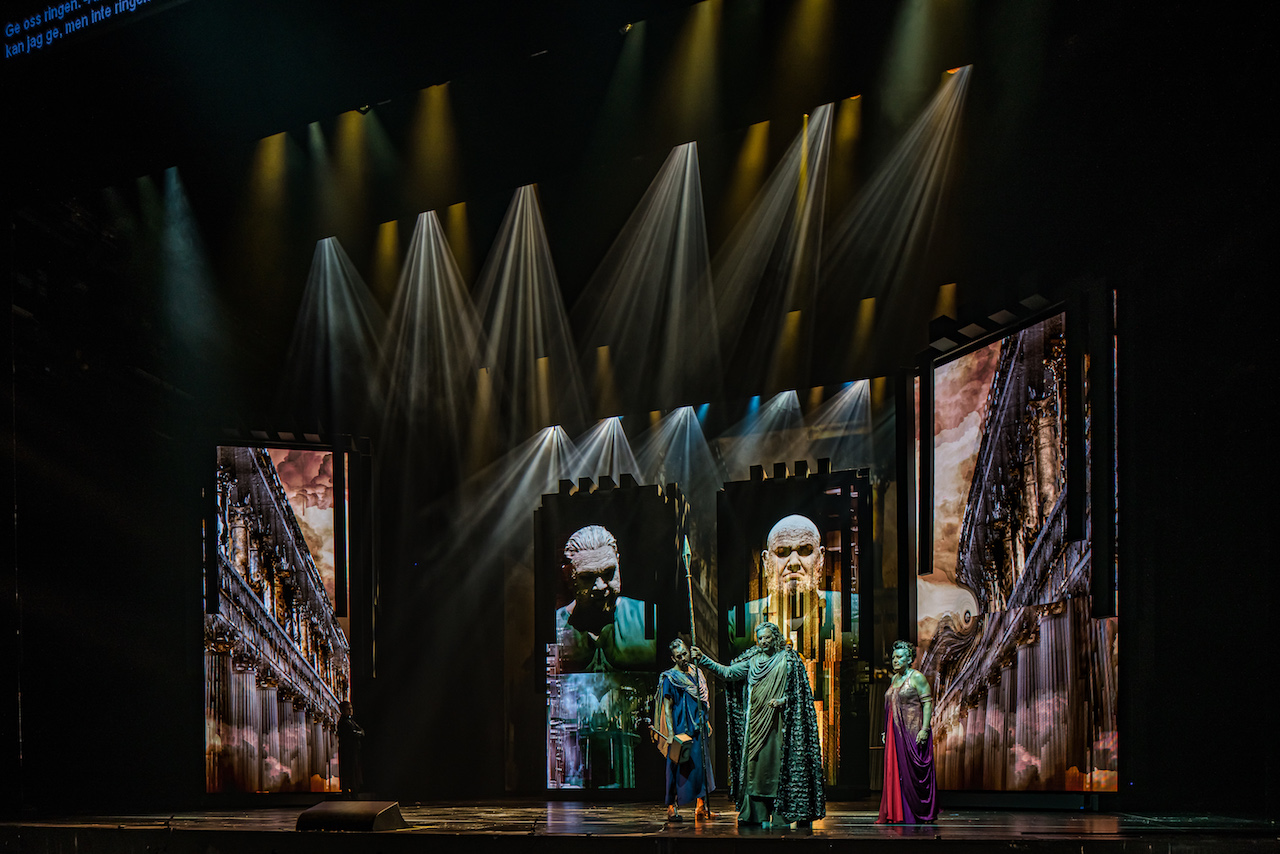
Rheingold at FNOB, 2019. Photographer – Ralph Larmann.
Anna Kelo’s concept envisions Das Rheingold as a starting point of the entire Ringstory, which happens in the prehistoric (or ancient) times, while further installments of the Ring will happen during the WWII (Die Walküre), contemporary times (Siegfried) and the apocalyptic future (Die Götterdämmerung). It is important for the director to constantly draw the line between the decisions of Gods (that are far from being wise and omnipotent) and the inescapability of a line of world energy that is moving in a certain direction regardless of the decisions and actions of Gods, semi-Gods, Nibelungs, etc. There is (and director speaks about it) a certain Buddhist quality to her production. The cyclical world perception of this religion corresponds with the nature of Wagner’s Ring(the composer himself was interested in Buddhism when conceiving it). The production combines stage decisions that play on changing color schemes, fairy-like constructions for Nibelungs’ world, and the abode of Rhein daughters and Gods’ dwelling, Walhalla. There are also innovative digital and video decisions (Mikki Kunttu’s inventive work) involving giants Fafner and Fasolt represented by two huge greenish projections (while the singers, clad in black, stay on either side of the stage), thunder and lightning elements, interesting video of a dragon (Alberich boasts the qualities of his Tarnhelm by becoming one) and black-and-white projections for the final Walhalla vision.
Neither Kelo nor Kunttu overdo the furnishing of the set with objects, sometimes leaving the stage almost bare and allowing the audiences to focus on vocal parts and the general structure of Wagner’s opera that tells so much through music and leitmotifs. It was especially easy for audiences at FNOB to be attentive to the music, as Esa-Pekka Salonen was doing excellent work in the pit, driving the opera forward in a dynamic way, but never forgetting to highlight special moments in the opera. Musical highlights included the appearance of Rhein gold, the revenge and hatred of Alberich, the arrival of the giants, and the Loge’s line, culminating in the final moments of the opera where the leitmotifs of the next parts of the tetralogy are already introduced, with many hints to the future tragedy of Gods’ death already there in Wagner’s music. Salonen was also very attentive to the singers, starting with Rhein daughters (there was beautiful singing from trio Tepponen, Palo and Packalen), Alberich’s scene, and with Wotan’s final appearance. Every vocalist was allowed to explore his or her character according to their temperaments. Tuomas Katajala was particularly impressive as a witty Loge, and Dan Karlström shined in his appearance as Mime, never afraid of revealing the cowardliness of the Nibelung. Tommi Hakala, Lilli Paasikivi (Fricka) and the rest of the “Gods” did an immensely fine job, accentuating the human side of those who are supposed to be the rulers of the universe. The orchestra of FNOB sounded on top of its form, taking the conductor’s energy and dynamism. The journey to this world, where power is fought for at different levels, where female love is important to boost life’s energies, and where choices are made and their consequences faced, was immense and hugely captivating. The sold-out run of all six performances of Das Rheingold was a cultural event for Helsinki and the FNOB, with future intricacies of Wagner’s world soon to come.
This post was written by the author in their personal capacity.The opinions expressed in this article are the author’s own and do not reflect the view of The Theatre Times, their staff or collaborators.
This post was written by Yulia Savikovskaya.
The views expressed here belong to the author and do not necessarily reflect our views and opinions.

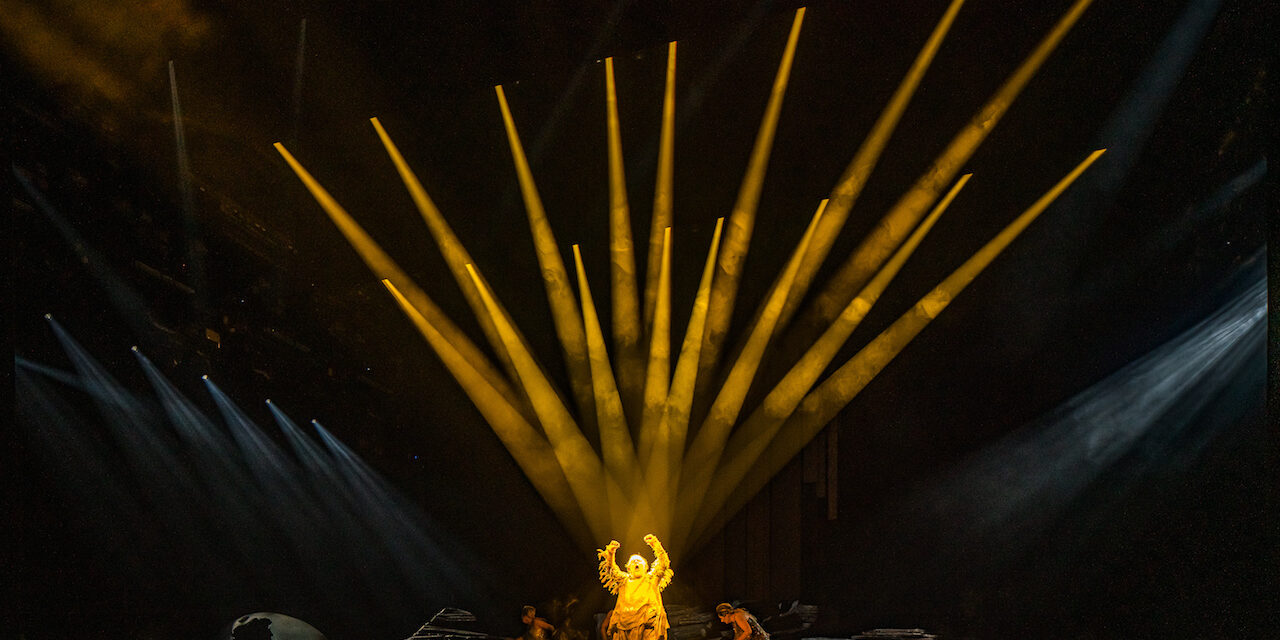
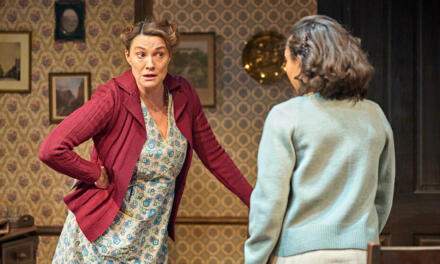
![Medea as a Border-Body [Part I]](https://thetheatretimes.com/wp-content/uploads/2024/06/Image-2-440x264.jpg)
